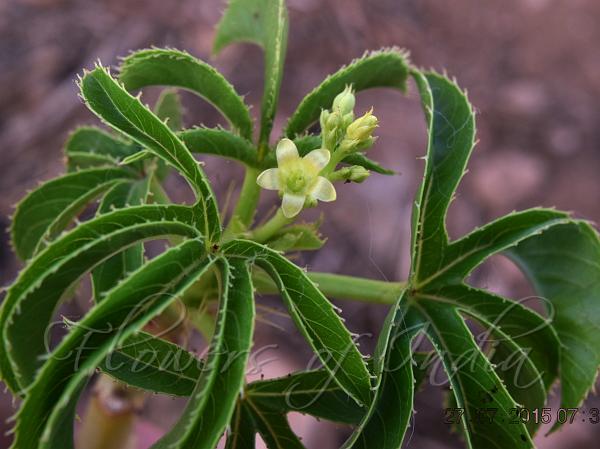|
| Glandular Jatropha |
|

|

| File size | 546438 |
| Original date | 7/27/15 7:38 AM |
| Resolution | 2048 x 1536 |
| Flash | Flash did not fire |
| Focal length | 55.0mm |
| Exposure time | 1/100s |
| Aperture | 14.0 |
| Focus Distance | |
| Metering Mode | Multi-segment |
| Camera make | NIKON CORPORATION |
| Camera model | NIKON D3300 |
| Sensor type | OneChipColorArea |
|
|
|
|
Photo: |
Botanical name: Jatropha glandulifera Family: Euphorbiaceae (Castor family)
Synonyms: Adenoropium roxburghii Kostel. [Illegitimate]
Synonyms: Adenoropium roxburghii Kostel. [Illegitimate]
Glandular Jatropha is an evergreen shrubs or
treelets 3 - 5 m tall, often shrub-like, with sticky, transparent
juice; trunk stout; branches with sparsely glandular hairy Leaves
simple, alternate, 5-15 cm long, 2.5 - 5-5 cm wide, base rounded or
flat, rarely shallowly heart-shaped, lower base with densely glandular
hairs, tip caudate, entire or near base bilateral 2-lobed, lobes
triangular, pointed, sometimes toothed, glandular-hairy above, hairless
below, margins sparsely glandular-pilose; basal veins 5, lower base
with densely glandular hairs; leaf-stalks 2 - 9 cm long,
glandular-hairy. Flower are borne In cymes, greenish yellow. Fruit A
capsule, three-lobed. Glandular Jatropha is found in Peninsular India,
Sri Lanka and tropical Africa. Fruiting throughout the year. Flowering:
All year.
Medicinal uses: Root and oil from seed is
purgative. Oil is considered antirheumatic, antiparalytic. Used
externally on ringworm and chronic ulcers. Roo is used for glandular
swellings. Latex is applied to warts and tumours.
Root and oil from seed is
purgative. Oil is considered antirheumatic, antiparalytic. Used
externally on ringworm and chronic ulcers. Roo is used for glandular
swellings. Latex is applied to warts and tumours.
Medicinal uses:
 Root and oil from seed is
purgative. Oil is considered antirheumatic, antiparalytic. Used
externally on ringworm and chronic ulcers. Roo is used for glandular
swellings. Latex is applied to warts and tumours.
Root and oil from seed is
purgative. Oil is considered antirheumatic, antiparalytic. Used
externally on ringworm and chronic ulcers. Roo is used for glandular
swellings. Latex is applied to warts and tumours. | Identification credit: S. Kasim | Photographed in Tamil Nadu. |
• Is this flower misidentified? If yes,